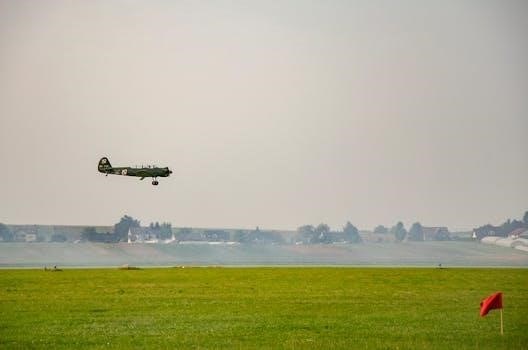
World War II Aircraft⁚ General Overview
World War II saw aviation evolve dramatically, becoming a crucial component of modern warfare. Diverse aircraft types, including iconic fighters and innovative bombers, significantly impacted strategies and outcomes. Aviation’s influence extended from the Battle of Britain to Pacific fleet battles.
World War II firmly established aviation as a critical aspect of modern warfare. From the Battle of Britain to the Pacific theater, aircraft played a pivotal role. Military investment spurred rapid advancements, transforming military aviation. The war witnessed tremendous growth in American military aviation, expanding from approximately 2,500 airplanes to nearly 300,000 by its conclusion.
Aircraft proved their worth in diverse roles, including air defense, ground support, maritime patrol, and shipping interdiction. Renowned aircraft shaped essential components of military aviation, profoundly impacting strategies and outcomes. Key technologies like aerodynamics, materials science, and propulsion systems enhanced aircraft efficiency and combat effectiveness. The aerial battles significantly shaped the course of the conflict.
The role of flight in World War II was undeniably a decisive factor influencing the war’s outcome. The streamlined cantilever monoplane became the standard, marking a significant leap in aviation technology. The diverse aircraft types and aerial combat tactics all contributed significantly to the war effort.
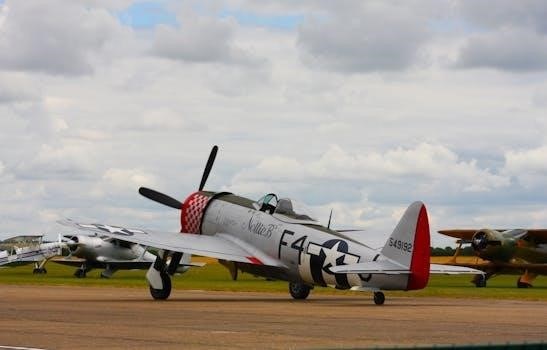
Fighter Aircraft of WWII
Fighter planes were vital for air superiority, engaging and destroying enemy aircraft. Iconic fighters like the Spitfire, Bf 109, and P-51 Mustang boasted exceptional maneuverability, firepower, and range, shaping aerial combat.
Role of Fighter Planes in Air Superiority
Fighter aircraft played a pivotal role in World War II, primarily tasked with achieving and maintaining air superiority over battlefields. Their primary mission involved engaging and destroying enemy aircraft, which included intercepting bombers and other fighters to protect friendly forces and strategic assets. Securing air superiority was crucial for a multitude of reasons, including enabling offensive operations, providing cover for ground troops, and disrupting enemy supply lines.
Fighters would actively seek out and eliminate enemy aircraft, denying the opposition the ability to conduct effective bombing raids or reconnaissance missions. Moreover, air superiority allowed for unhindered aerial reconnaissance, providing valuable intelligence for strategic planning and tactical decision-making. The success of ground offensives often hinged on the ability of fighter aircraft to control the skies, ensuring that friendly troops could advance without the constant threat of aerial bombardment.
Ultimately, the control of the skies gained by fighter planes dictated the flow of battle.
Iconic Fighter Planes⁚ Spitfire, Bf 109, P-51 Mustang
The Supermarine Spitfire, Messerschmitt Bf 109, and North American P-51 Mustang stand as iconic symbols of World War II air combat. Each of these fighter planes possessed exceptional maneuverability, firepower, and range, making them formidable adversaries in the skies.
The Spitfire, a British single-seat fighter, was renowned for its elegant design and agility, playing a crucial role in the Battle of Britain. The Bf 109, a German fighter, was a mainstay of the Luftwaffe, known for its speed and adaptability. The P-51 Mustang, an American long-range fighter, provided crucial escort for bombers deep into enemy territory, altering the course of the air war.
These aircraft, with their unique strengths and historical significance, shaped the aerial landscape of World War II, influencing tactics and outcomes. Their designs pushed the boundaries of aviation technology and were essential to the war effort. The legacy of these iconic fighters continues to inspire aviation enthusiasts.
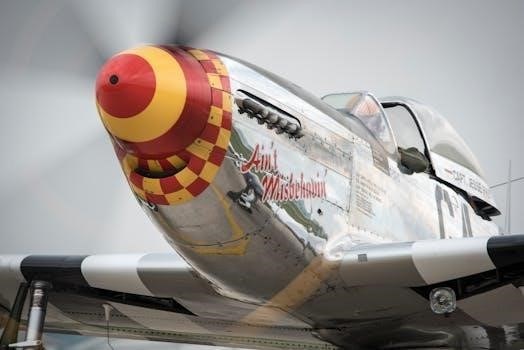
Bomber Aircraft of WWII
Many bombers were used during World War II. The B-17, B-24, B-26, and B-29 were essential to the AAF fleet. Bombers were crucial for strategic bombing campaigns and supporting ground operations.
Key Bomber Models⁚ B-17, B-24, B-29
The Boeing B-17 Flying Fortress was a workhorse of the AAF fleet, known for its ability to sustain heavy damage and return home. The Consolidated B-24 Liberator was produced in larger quantities and had a longer range, making it suitable for missions in the Pacific Theater. These aircraft were vital for strategic bombing campaigns.
The B-29 Superfortress represented a significant technological leap, featuring pressurized cabins and remote-controlled gun turrets. Its most notable role was in delivering atomic bombs to Hiroshima and Nagasaki. The B-25 Mitchell also played a significant role in the war effort.
The B-26 also played a role in WWII. These bombers were essential for impacting strategies and outcomes. Renowned aircraft shaped essential components of military aviation. These bombers represent the diverse and dynamic nature of aerial warfare during World War II.
The Douglas A-20 Havoc
The Douglas A-20 Havoc, sometimes overlooked, was a versatile and effective bomber during World War II. Considered a pilot’s favorite, it excelled in various roles, including ground attack, night fighting, and reconnaissance. Its adaptability made it valuable across different theaters of operation, contributing significantly to Allied air power.
The A-20 was known for its speed, maneuverability, and robust construction. It was used by multiple Allied nations, including the United States, Soviet Union, and Great Britain, highlighting its widespread appeal and effectiveness. Its contributions often go unnoticed despite its crucial role in numerous campaigns and battles;
The Douglas A-20 Havoc’s design allowed it to be modified with ease. This allowed for increased versatility in the war. The Douglas A-20 Havoc was certainly one of the best bombers of WWII.
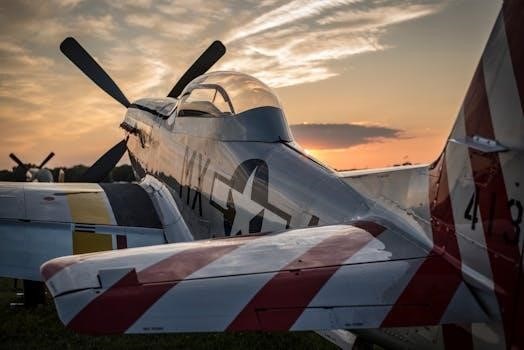
Technological Advancements in WWII Aircraft
Aircraft development in WWII was marked by significant advancements that transformed military aviation. Key technologies included aerodynamics, materials science, and propulsion systems, each contributing to the overall efficiency and combat effectiveness.
Aerodynamics
Advancements in aerodynamics during World War II significantly enhanced aircraft performance. Streamlined designs became increasingly prevalent, reducing drag and enabling higher speeds. The transition to cantilever monoplanes further improved aerodynamic efficiency, eliminating the need for external bracing and allowing for cleaner wing profiles. Engineers meticulously refined wing shapes, experimenting with different airfoils to optimize lift and minimize turbulence.
These aerodynamic improvements translated directly into enhanced combat capabilities. Fighters became more maneuverable, allowing them to outturn and outmaneuver their opponents in dogfights. Bombers benefited from increased speed and range, enabling them to reach distant targets and evade enemy interception. The pursuit of aerodynamic perfection was a constant endeavor, driving innovation and ultimately contributing to the Allied victory. Understanding and manipulating airflow became a key factor in aircraft design, shaping the evolution of military aviation throughout the war.
Materials Science
World War II spurred significant advancements in materials science, crucial for enhancing aircraft performance and durability. The demand for stronger, lighter materials led to the widespread adoption of aluminum alloys. These alloys offered a superior strength-to-weight ratio compared to earlier materials, enabling aircraft to fly faster and carry heavier payloads. New techniques for casting and forming metals were developed to produce more complex and robust aircraft components.
Furthermore, the use of composite materials, such as plywood and reinforced plastics, began to emerge. These materials offered unique properties, including resistance to corrosion and the ability to be molded into complex shapes. As the war progressed, the need for heat-resistant materials became increasingly important, particularly for jet engines. The development of high-temperature alloys allowed for the creation of more powerful and efficient engines, paving the way for the jet age. These advancements in materials science directly contributed to the improved performance and reliability of WWII aircraft.
Propulsion Systems
World War II witnessed rapid advancements in aircraft propulsion systems, significantly boosting performance. The primary focus remained on piston engines, with innovations like supercharging and turbocharging enhancing power output at high altitudes. These systems compressed intake air, allowing engines to burn more fuel and generate greater thrust, crucial for fighter planes and bombers operating at higher altitudes. Engine designs were refined to improve fuel efficiency and reliability, extending the range and operational capabilities of aircraft.
The war also marked the dawn of jet propulsion. While early jet engines were relatively unreliable and fuel-inefficient, their potential for high-speed flight was undeniable. The German Messerschmitt Me 262 became the first operational jet fighter, showcasing the revolutionary capabilities of this new technology. Although jet aircraft saw limited use in WWII, their development laid the foundation for future generations of high-performance military and civilian aircraft. The advancements in both piston and jet engine technology fundamentally transformed aviation during the war.
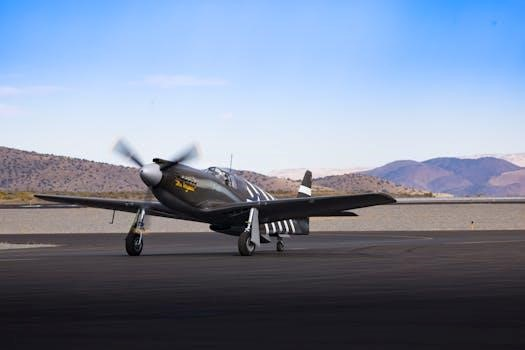
Impact of Aviation on WWII Outcome
Aviation played a decisive role in shaping the outcome of World War II, influencing nearly every aspect of the conflict. Air superiority became paramount, with fighter planes battling for control of the skies, enabling bombing campaigns and protecting ground forces. Strategic bombing crippled enemy industries, disrupted supply lines, and weakened morale, while tactical air support provided crucial assistance to ground troops, enabling them to advance and overcome enemy defenses.
The war also witnessed the rise of naval aviation, with aircraft carriers becoming central to naval power. Carrier-based aircraft played a pivotal role in the Pacific theater, engaging in decisive battles that shifted the balance of power. Furthermore, transport aircraft facilitated the rapid deployment of troops and supplies, enabling Allied forces to conduct operations across vast distances. The development and deployment of nuclear weapons delivered by airpower brought the war to a swift and devastating conclusion, underscoring the profound impact of aviation on the global conflict and changing the face of future warfare.